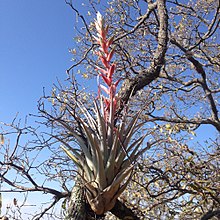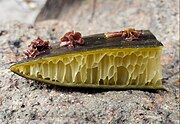
Spanish moss is an epiphytic flowering plant that often grows upon large trees in tropical and subtropical climates. It is native to much of Mexico, Bermuda, the Bahamas, Central America, South America, the Southern United States, and West Indies. It has been naturalized in Queensland (Australia). It is known as "grandpa's beard" in French Polynesia.

Tillandsia is a genus of around 650 species of evergreen, perennial flowering plants in the family Bromeliaceae, native to the forests, mountains and deserts of the Neotropics, from northern Mexico and the southeastern United States to Mesoamerica and the Caribbean to central Argentina. Their leaves, more or less silvery in color, are covered with specialized cells (trichomes) capable of rapidly absorbing water that gathers on them.

A lichen is a composite organism that arises from algae or cyanobacteria living among filaments of multiple fungi species in a mutualistic relationship. Lichens are important actors in nutrient cycling and act as producers which many higher trophic feeders feed on, such as reindeer, gastropods, nematodes, mites, and springtails. Lichens have properties different from those of their component organisms. They come in many colors, sizes, and forms and are sometimes plant-like, but are not plants. They may have tiny, leafless branches (fruticose); flat leaf-like structures (foliose); grow crust-like, adhering tightly to a surface (substrate) like a thick coat of paint (crustose); have a powder-like appearance (leprose); or other growth forms.
This glossary of ecology is a list of definitions of terms and concepts in ecology and related fields. For more specific definitions from other glossaries related to ecology, see Glossary of biology, Glossary of evolutionary biology, and Glossary of environmental science.

Pioneer species are hardy species that are the first to colonize barren environments or previously biodiverse steady-state ecosystems that have been disrupted, such as by wildfire.
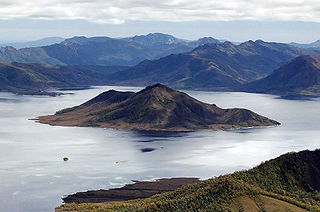
The Tasmanian temperate rain forests are a temperate broadleaf and mixed forests ecoregion in western Tasmania. The ecoregion is part of the Australasian realm, which includes Tasmania and Australia, New Zealand, New Guinea, New Caledonia, and adjacent islands.

Lithophytes are plants that grow in or on rocks. They can be classified as either epilithic or endolithic; epilithic lithophytes grow on the surfaces of rocks, while endolithic lithophytes grow in the crevices of rocks. Lithophytes can also be classified as being either obligate or facultative. Obligate lithophytes grow solely on rocks, while facultative lithophytes will grow partially on a rock and on another substrate simultaneously.
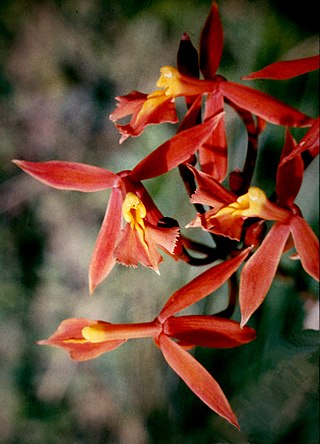
Epidendroideae is a subfamily of plants in the orchid family, Orchidaceae. Epidendroideae is larger than all the other orchid subfamilies together, comprising more than 15,000 species in 576 genera. Most epidendroid orchids are tropical epiphytes, typically with pseudobulbs. There are, however, some terrestrials such as Epipactis and even a few myco-heterotrophs, which are parasitic upon mycorrhizal fungi.

Primary succession is the beginning step of ecological succession after an extreme disturbance, which usually occurs in an environment devoid of vegetation and other organisms. These environments are typically lacking in soil, as disturbances like lava flow or retreating glaciers scour the environment clear of nutrients.

Catopsis berteroniana, commonly known as the powdery strap airplant or the lantern of the forest, is an epiphytic bromeliad thought to be a possible carnivorous plant, similar to Brocchinia reducta, although the evidence is equivocal. Its native range is from southern Florida to southern Brazil. It generally grows on the unshaded twigs of trees, and has been shown experimentally to trap more insects in its tank than other bromeliads of comparable size. There are several other species in the genus, none of which is believed to be carnivorous.

An aquatic ecosystem is an ecosystem found in and around a body of water, in contrast to land-based terrestrial ecosystems. Aquatic ecosystems contain communities of organisms—aquatic life—that are dependent on each other and on their environment. The two main types of aquatic ecosystems are marine ecosystems and freshwater ecosystems. Freshwater ecosystems may be lentic ; lotic ; and wetlands.
Fragmentation in multicellular or colonial organisms is a form of asexual reproduction or cloning, where an organism is split into fragments upon maturation and the spilted part becomes the new individual.
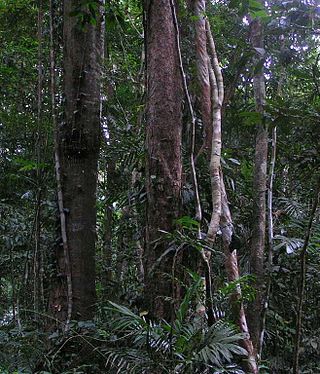
Forest ecology is the scientific study of the interrelated patterns, processes, flora, fauna and ecosystems in forests. The management of forests is known as forestry, silviculture, and forest management. A forest ecosystem is a natural woodland unit consisting of all plants, animals, and micro-organisms in that area functioning together with all of the non-living physical (abiotic) factors of the environment.
A lithosere is a plant succession that begins life on a newly exposed rock surface, such as one left bare as a result of glacial retreat, tectonic uplift as in the formation of a raised beach, or volcanic eruptions. For example, the lava fields of Eldgjá in Iceland where Laki and Katla fissures erupted in the year 935 and the solidified lava has, over time, begun to form a lithosere.
Ecological facilitation or probiosis describes species interactions that benefit at least one of the participants and cause harm to neither. Facilitations can be categorized as mutualisms, in which both species benefit, or commensalisms, in which one species benefits and the other is unaffected. This article addresses both the mechanisms of facilitation and the increasing information available concerning the impacts of facilitation on community ecology.
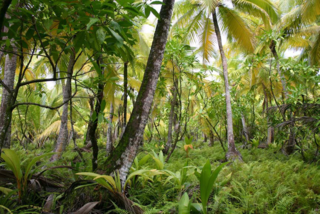
Plant ecology is a subdiscipline of ecology that studies the distribution and abundance of plants, the effects of environmental factors upon the abundance of plants, and the interactions among plants and between plants and other organisms. Examples of these are the distribution of temperate deciduous forests in North America, the effects of drought or flooding upon plant survival, and competition among desert plants for water, or effects of herds of grazing animals upon the composition of grasslands.
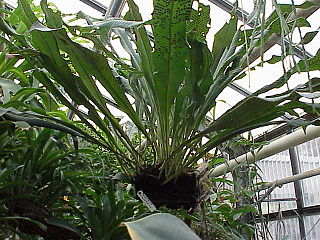
Niphidium crassifolium, commonly known as the graceful fern, is a species of fern in the family Polypodiaceae found in Central and South America. It is predominantly epiphytic, growing on other plants—for example, in the canopies of trees—but occasionally grows on rocks or on the ground, particularly at higher altitude. It has a rhizome from which many fine rootlets covered in dark reddish-brown scales grow. Together they form a root basket that, when growing on trees, helps to trap leaf litter and dust, forming a nutrient-rich soil that holds water. Its leaves are simple in shape, 13–85 centimetres (5–33 in) long and 3–5 centimetres (1.2–2.0 in) wide and when dry, and covered by a wax-like film. The sori are round and large, occurring in single rows between veins at the far end of the leaf.

Rhytidiadelphus loreus, also commonly known as lanky moss and Little Shaggy Moss, is a nonvascular "feather moss" species that is a key component of a healthy, thriving forest ecosystem. Lanky moss grows in North America, Canada and Europe. It is primarily a coastal species that grows in moist, coniferous and deciduous forests, acidic grasslands and in the UK, heathy slopes on mountains. It grows on decaying logs, the forest floor and as an epiphyte on living trees. Its key functions in the ecosystem are water retention and temperature insulation.
Canopy soils, also known as arboreal soils, exist in areas of the forest canopy where branches, crevices, or some other physical feature on a tree can accumulate organic matter, such as leaves or fine branches. Eventually, this organic matter weathers into some semblance of a soil, and can reach depths of 30 cm in some temperate rainforests. Epiphytes can take root in this thin soil, which accelerates the development of the soil by adding organic material and physically breaking up material with their root system. Common epiphytes in the canopy soils in temperate rainforests include mosses, ferns, and lichens. Epiphytes on trees in the temperate zone are often ubiquitous and can cover entire trees. Some host trees house up to 6.5 tons dry weight of epiphytic biomass, which can equate to more than 4x of its own foliar mass. This massive presence means their dynamics need to be better understood in order to fully understand forest dynamics. The nutrients that become stored within canopy soils can then be utilized by the epiphytes that grow in them, and even the tree that the canopy soil is accumulating in through the growth of canopy roots. This storage allows nutrients to be more closely cycled through an ecosystem, and prevents nutrients from being washed out of the system.
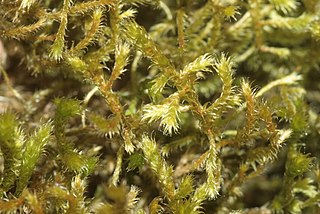
Antitrichia curtipendula is a species of feather-moss found predominantly in western North America and the western coast of Europe.
